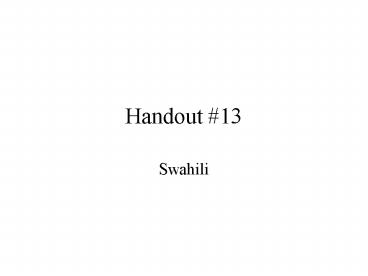Handout - PowerPoint PPT Presentation
Title:
Handout
Description:
Handout #13. Swahili. Swahili (Tanzania, Kenya): Data (Halle and Clements 1983: 133) ... m - fuko/ /m -bale/ Nasal place assimilation / - fuko/ / -bale/ /w ... – PowerPoint PPT presentation
Number of Views:135
Avg rating:3.0/5.0
Title: Handout
1
Handout 13
- Swahili
2
Swahili (Tanzania, Kenya) Data(Halle and
Clements 1983 133)
3
Data
4
Data
5
Alternating morphemes
- The singular differs from the plural in that it
begins with u or w. - The morpheme meaning singular is therefore u
w. - Instead of u or w, the plural has different
nasals. - The morpheme meaning plural is therefore m
n N ø .
6
Alternating sounds
- In this case, each alternating morpheme consists
of a single sound, so the list of alternating
sounds is identical to the list of alternating
morphemes - u w
- m n N ø
7
Distribution of the alternating sounds
- u w
- w does not occur before a consonant, but does
occur elsewhere. - u occurs before a consonant, as well as
elsewhere. - m n N
- A nasal does not occur before a consonant with a
different place of articulation, but does occur
elsewhere.
8
Distribution of the alternating sounds
- nasal ø
- nas -son, cont
- Syllabic nasal
- A syllabic nasal occurs only at the beginning of
a word before a consonant. - A nonsyllabic nasal occurs only elsewhere.
9
Analysis
- Underlying representations of the alternating
morphemes - /w, /
- Rules
- Nasal deletion
- nas --gt ø / ___ -son, cont
- Syllabic formation
- C --gt V / ____ C
10
Rules
- Nasal place assimilation
- nas --gt a Place / ___ C
a Place - As in Handout 12, alpha (a) is a variable over
feature coefficients ( or -). - Place is a variable over place features lab,
cor, ant, dist, back. - So in a rule with two sounds marked a Place,
the sounds must match in all place features. - This rule makes the nasal match the following C
in place of articulation.
11
Derivations
12
Reference
- Halle, Morris, and G.N. Clements (1983). Problem
Book in Phonology. MIT Press, Cambridge.































